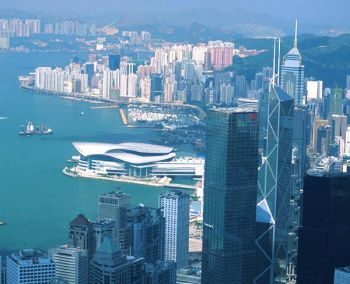
Hong Kong's economic integration with the Pearl River Delta (PRD) has been highly beneficial for all parties. It is expected to further expand economic ties and help improve cooperation among Hong Kong, Macao and mainland China.
HK set to play big role in south's progress
Chinese Vice-Premier Li Keqiang hailed Hong Kong's important role in cooperation among Guangdong, Hong Kong and Macao during a visit to Hong Kong in 2011.
At a forum held in Hong Kong, Li also urged the strengthening of Guangdong's network with Hong Kong to supply the bordering special administrative region with water, electricity and gas.

Guangdong, one of the country's economic powerhouses, is ready for the expansion of ties with Hong Kong, which is playing an increasingly important role in Guangdong's economic construction.
Investment from Hong Kong represents about 75 percent of Guangdong's overseas investment, and Hong Kong is the province's biggest trading partner.
Zhao Yufang, vice-governor of Guangdong, said the country's 12th Five-Year Plan (2011-2015) requires Guangdong to expand cooperation with Hong Kong and Macao.
"And Guangdong would certainly redouble efforts to develop the relationship with Hong Kong in the following years, benefiting both sides," Zhao said.
In particular, Zhao expects to expand cooperation with Hong Kong and Macao on logistics, finance, high-tech and service industries and join the two special administrative regions to build a world-class metropolitan cluster in the southern Chinese region.
Cooperation with Hong Kong and Macao not only helps Guangdong with its international competitiveness, but the province has also been upgrading its processing and manufacturing industries, he added.
Guangdong and Hong Kong have established a very close relationship since the country introduced the reform and opening-up policy in the late 1970s.
The two regions established the Hong Kong-Guangdong Cooperation Joint Conference to bolster economic ties in 1998. Senior government officials from both sides meet annually to expand cooperation and mutual development.
In 2010, Guangdong signed a framework agreement on cooperation in Beijing to further develop economic ties.
The agreement was signed by Guangdong Governor Huang Huahua and Hong Kong Chief Executive Donald Tsang in the Great Hall of the People, with Vice-President Xi Jinping.
Bridge links HK, Macao and mainland
Hong Kong began construction of its part of the world's longest cross-sea bridge linking the city with Macao and Zhuhai in late 2011, after the project was delayed for a year by a legal challenge over its environmental impact.
The Hong Kong section of the massive bridge linking Hong Kong, Zhuhai and Macao includes three major projects -- Hong Kong boundary crossing facilities, the Hong Kong Link Road as well as the detailed design of Tuen Mun-Chek Lap Kok Link and Tuen Mun Western Bypass. In total, the three projects are expected to cost 48.5 billion HK dollars ($6.2 billion).
Hong Kong boundary crossing facilities has the largest investment among the three projects, with a budget of 30.43 billion HK dollars.
A 150-hectare artificial island would be built in the waters northeast of Hong Kong International Airport to house the boundary crossing facilities.
Construction of the Hong Kong section will be completed on schedule, enabling the bridge to be operational in 2016.
Donald Tsang said the Hong Kong-Zhuhai-Macao Bridge is strategically important, and would further facilitate the economic integration and development of Hong Kong, Macao and the mainland.
The bridge will significantly reduce transportation time by 60 percent to 80 percent for travelers and goods, as well as reduce the costs, according to official statistics.
Upon completion of the bridge, western Pearl River Delta cities will fall within a three-hour radius of Hong Kong, Tsang said, adding that Hong Kong investors will have plenty of business opportunities in the western Pearl River Delta, which is rich in human and land resources.
In the long run, the bridge is set to create a new era in transportation link between Hong Kong and the mainland, inject new impetus to Hong Kong's long-term economic development, and generate new opportunities for Hong Kong's main industries such as tourism, finance, trade, commerce and logistics, he said.
The Hong Kong-Zhuhai-Macao Bridge, with a total length of 29.6 km, will be the world's longest cross-sea bridge. Its total estimated cost is $11.5 billion and is expected to be completed by the end of 2016. The cost will be shared by the authorities of mainland China, Hong Kong and Macao.
Construction began in December 2009 at the Zhuhai section of the bridge.
Pearl River Delta airspace integration plan
The Pearl River Delta Air Traffic Management Planning and Implementation Working Group has formulated an integration plan to resolve long-term regional airspace congestion, a Hong Kong Special Administrative Region official said.
The working group was formed by civil aviation authorities from the mainland, the Hong Kong Special Administrative Region, and the Macao Special Administrative Region.
Hong Kong's Secretary for Transport and Housing Eva Cheng told lawmakers the plan encompasses measures to rationalize airspace design, enhance flight level distribution, standardize interface and protocols of air traffic control systems, and establish extra civil aviation air routes for flights to and from the northern and eastern parts of the Chinese mainland.
"Upon full implementation of the plan, future air traffic growth in the region will be met by enhanced PRD airspace capacity," Cheng said.
The three sides will progressively improve air-traffic operations in the short term, and streamline airspace management, air-traffic control and flight procedures over the Pearl River Delta region in the long term.
The Civil Aviation Department of Hong Kong is increasing runway capacity at Hong Kong International Airport to achieve 68 aircraft movements per hour by 2015.
The Airport Authority of Hong Kong will conduct a mid-field expansion project to provide extra aircraft stands and apron facilities, and a new passenger concourse, increasing the airport's handling capacity to 70 million passengers and 6 million tons of cargo per year, to cope with air traffic demand up to 2020.